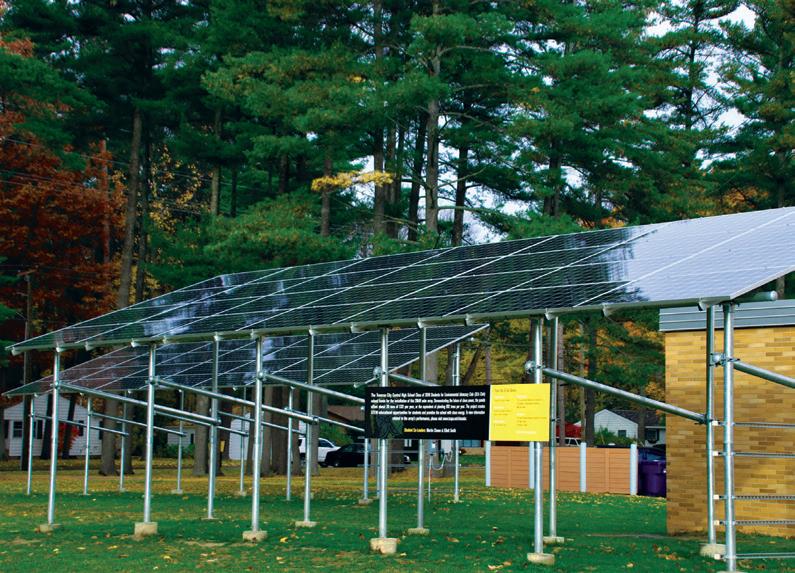
13 minute read
Piering into the Future
Graphics Courtesy of R. Soyring
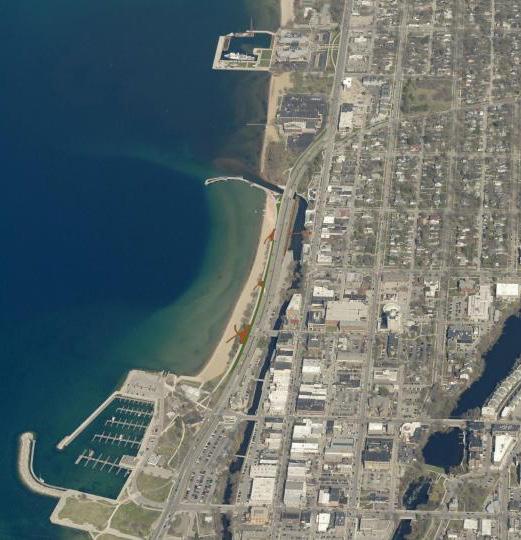
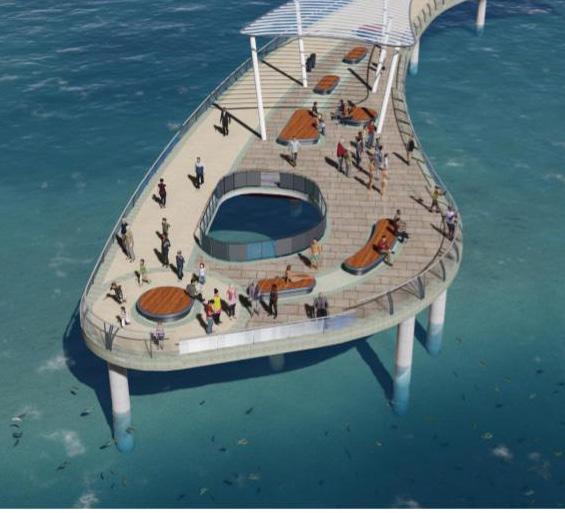
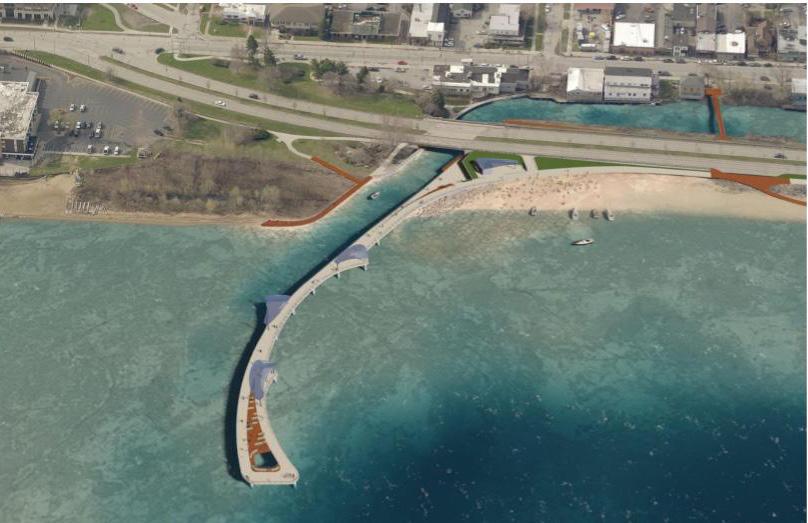
The heart and soul of Traverse City is its water. Tour ists flock from far and wide to take a dip in the spar kling waters of East Bay, to climb Pyramid Point for a breathtaking view of Lake Michigan, to catch a daz zling sunset over West Bay, or to just simply enjoy a hot summer day on the water. So, when waterfront plans for West Bay began to take shape in 2006, it was a big deal for Traverse City locals and tourists alike. Traverse City’s waterfront has always been chang ing and adapting. The Clinch Park and Open Space areas are the two integral parts of the waterfront that have seen the most public use, and therefore a lot of change. A zoo and powerplant are just two of the many structures that have been present in that area in the past twenty years. Michigan State University students drew up the previously mentioned waterfront plans in 2006, which included the addition of a brand new public pier in West Bay near downtown. The pier really caught the attention of Traverse City’s City Plan ning Director, Russ Soyring, who has worked under the title for 34 years. Soyring claims to have had the possi bility of a Traverse City public pier in his mind since the 1990’s, but it really became a focus for him in 2006, with the first real plans for the project. The city wanted to hear public opinion on the project, “we involved the community, we had hundreds of people come out and look at it [the pier designs],” explained Soy ring, “a lot of people really liked the pier and coming out with that idea.” Due to the overwhelming public support and interest, the city decided to dive deeper into the project. “In 2010, we used professionals, we had consultants that helped us, we were doing the whole bayfront plan,” stated Soyring. With each new design, the plans for the pier became more and more detailed and complex, until they were almost to the point of being able to begin construction. The pier was not just another expensive and time con suming change to Traverse City’s downtown water front, it had the potential to impact the lives of many. “The idea of the pier was that we wanted to improve access to the waterfront, we wanted to give more op portunities for the public to enjoy it,” Soyring reasoned, “Not everyone can afford to be on the waterfront, to live there, but we can make more opportunities to view the water.” The other major vision of the pier was to encourage local fishing. Later down the road, another consulting firm was hired to help develop the plans further. After draw ing up these more detailed plans, the public was asked “what kinds of things would you like to see on the waterfront?” Soyring explained, “and the pier got a lot of ‘yes we really like it!’” The project then received a $232,000 grant that helped it continue to advance and develop. Although the pier received a lot of positive feedback and support from the public, there were still people who had concerns, or who were entirely opposed to the project. These concerns included the pier harming the local environment, and whether or not the pier would be easily accessible to emergency services.. There were two locations considered for the future home of the pier, both within Traverse City’s down town waterfront. The first proposed location was to have the pier as an extension of the Open Space, and the second was to have it at the mouth of the Boardman River. In the end, the mouth of the Board man won the location battle due to the heavy wave action at the Open Space and the better fishing near the river. “This is the best place you’re going to catch fish,” Soyring said of the Boardman River mouth loca tion, “ they have a lot of fish habitat at the mouth, a lot of what they call ‘nutrients’ coming down the river, and the fish like the nutrients so they come up and they eat in that area and then that’s an opportunity to catch fish.” It was critical to both the people working on the pier and the public that the pier not just be an expensive structure altering the face of West Bay, or what de tractors called a “mistake on the lake.” “We went through a number of [design] variations, the com munity was saying ‘we just don’t want a kind of ugly thing sticking out of the bay, we want something that looks very artful, really, something beautiful that you’d want to photograph,’”explained Soyring. Jack Knol was an architect and pier committee member for the project. This was his first time designing a pier, and he explained that something this big and complex takes him “typically 9 to 12 months after permits secured. by: MARIA LINCK content editor A public pier HAD the potential to change Traverse City’s waterfront forever.
Permits take probably 3-4 months.” Many factors go into designing a pier, including getting the correct permits and studying environmental factors such as currents, ice thickness, wave height, and wind history. Some of the factors more specific to this pier that Knol listed are “fishing structures, ADA features, building codes, life safety issues, maintenance factors, public access, accessible parking, bike access, pedestrian access, fish cleaning stations, shade structures, wa ter access, lighting, restrooms, and aesthetics, and a whole lot more.” With the main goal of the pier being to connect more people with the waterfront, public access was very prominent in the design process. The idea was to “have a walkway all the way from Clinch Park Beach area all along here [Parkway along Clinch Park Beach], kind of a promenade that you could walk along, and then you could walk out onto the pier,” Soyring stated. Due to good fishing in the area, a fishing hole at the end of the pier was also integrated into the design. Soyring explained that the fishing hole would create shade, and the plan was “to put habi tat, big boulders and logs, underneath it so fish would like to come in there and then you could drop a line right in there and catch fish.” Another detail of the pier was the unique and environmentally friendly light ing that was going to be incorporated into the design. “We were talking about how we were going to light it [the pier] at night, how we could light it up different colors for the seasons. If Michigan State won, we’d do it all in green. If Michigan won we’d do it in blue. At Christmas we’d have green and red, and things like that,” explained Soyring. “We were going to put solar panels on top to help to generate the energy to light the lights at night.” Not only would the solar panels be an environmentally friendly source of energy, but they would also provide shaded areas on the pier. Traverse City is highly dependent on tourism, and a brand new downtown public pier could be the start of something much bigger that could ultimately change Traverse City forever. Jean Derenzy, CEO of the Down town Development Authority (DDA), claims that “just building the pier was not the ‘end all’, the pier need ed to result in a phased approach so the true picture of how the pier was connecting people to places, to the waterfront, to the downtown, to the neighbor hoods, is what could make the pier project a start of something transformational.” Although the pier did have the power to make a large impact on Traverse City’s tourism and economy as a whole, Derenzy sees it on a more personal level with the people of Traverse City. “When looking and considering major infrastruc ture it is not about the tourism aspect, it is about what will serve our community, our residents for generations to come,” she said. The grand total of the pier was projected to be $8,710,000. Broken down, the pier itself was going to cost around $5,360,000. Beach improvements near the base of the pier were at $660,000; Boardman River and downtown connections to the pier were predicted to cost $1,150,000; Connections to the pier from the East were at $630,000, and the walkway from Clinch Park along the beach to the pier was predict ed to cost $910,000. Soyring pointed out that the re cent Eighth Street construction cost 3-4 million dollars. After all of the hard work and detail that went into planning the pier, it was eventually put on the back burner. “We were really looking forward to doing this project, real excited about it, we had it all designed, we had it almost ready, permits and every thing, but then we had an election. We had differ ent city commissioners come in and they weren’t so interested in the pier. They said ‘you know, we have a lot of broken bridges, we have a lot of broken roads, sidewalks that are missing, that’s where we want to spend our money,’” reflected Soyring. Derenzy liked the idea of the pier as a whole, but thought it was “too consultant led and not enough public led, which resulted in the plan not being approved by the elect ed officials.” Even though the pier was discontinued, there have been many other projects going on in Traverse City, though none as unique and expensive as a new pier. The construction on Eighth Street and the five mile loop around the Boardman Lake are two major city development projects that have been under the spotlight in Traverse City recently. Along with these projects aimed toward making the city a more bike able and walkable place to live and visit, there are also plans in place with goals to preserve and protect the environment surrounding and within Traverse City. Keeping people from fertilizing their lawns right up to the shoreline is one of the environmental projects that Soyring is working on. “We’re trying to write some new rules and regulations to have more of a natural water’s edge with trees and shrubbery and wood and plants and dune grass, things that aren’t fertilized so we can protect the water quality, so we don’t have all those chemicals going into the waterfront, into the water,” he said, “I think we need to protect our water quality, it’s extremely important.” Soyring is also work ing on a tree ordinance that outlines rules for develop ments that wish to cut down trees in the city, and a street design manual to be used when streets have to be redone. Although Soyring wishes the city was mov ing forward with the pier, he remains optimistic in the fact that the pier will someday exist. “It’s not like the project is killed, but it’s been set on a shelf, waiting for a good time when we can address the pier again,” Soyring said, “I think the community really likes the pier and we’re probably going to go back to that some day. You might be grown-ups when you see it, but that’s okay.”//
The Earth, which is over four and a half billion years old, is inhabited by over seven billion people. Now compare the Earth, something so old and precious, to a person. You wouldn’t abandon them if they needed help. You would help them. According to the Ameri can Association for the Advancement of Science, 14 billion tons of plastic are dumped into the oceans yearly, leading to extreme toxicity and pollution. Hu mans are treating the Earth as an afterthought when it really should be at the forefront of our minds. Without the Earth, we as humans can not exist. Yet people still disrespect it, whether it is intentional or not. With debates about the world’s energy, use of plastics, and climate change becoming more and more frequent, it is clear that society is beginning to acknowledge the problem, but what are we actually doing about it? Locally, many restaurants such as The Jolly Pumpkin have switched to paper straws instead of plastic straws. Similarly, TCAPS is considering biode gradable options as well. These are all steps in the right direction to helping the environment. Another program taking these steps is Adopt-A-Stream, which has recently been gaining popularity in the Traverse City area. Adopt-A-Stream is a volunteer stream monitoring program, where volunteer teams collect important water quality and habitat data on wade able streams in the Grand Traverse Bay watershed. They monitor the streams twice per year, once in July, and once in August. Adopt-A-Stream data is very important. According to Heather Smith, the head of Adopt-A-Stream, it can be used to “establish water quality baselines, flag issues, assess restoration project efficiency, and is used by State water resource profes sionals to assess the condition of our area’s streams. It serves as a unique way to engage citizens in water shed stewardship and advocacy.” Last year AdoptA-Stream grew to over 80 participants and 25 stream sites. Heather Smith, the leader of Adopt-A-Stream says, “If you are interested in citizen science, this is a great way to learn about streams and invertebrates, and collect data critical in protecting and preserving our streams.” Madison Marshall, a Junior here at Central, is participating in Adopt-A-Stream because she wants to help the environment and gain experience from the program. “We all live in it [the environment] for our entire lives, so we should definitely take care of it. I don’t use plastics, like straws or plastic water bottles and I think that if everybody did this it can really make a difference.” Maddison wants to pursue a career in the science industry, so she also feels it would be good for her resume. “I do think that my future resume or college applications play a role in my choice to participate in environmental activities such as AdoptA-Stream because I want to be in the science indus try, but also I love the environment, and I think it’s important that we take care of it.“ Mike Foley, a retired exploration geologist, says he participates because “Virtually any science
by: NIKLAS FAGERMAN staff writer
Learn more about programs to preserve the environment in Tra verse City, like Adopt-A-Stream.
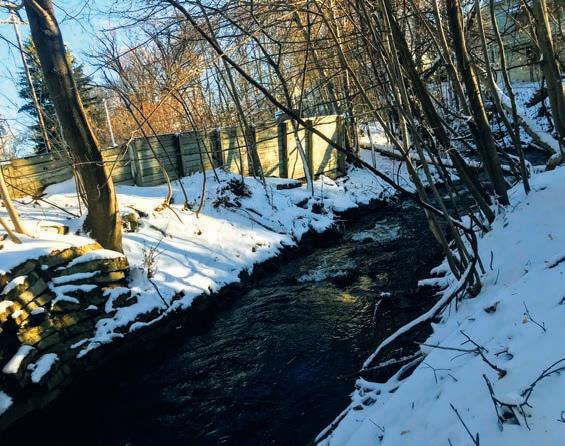
subject has always been of interest to me, and the opportunity to assist in ‘citizen science’ activities now that I have a bit more time in my schedule was ap pealing.” He recommends all students try out the pro gram. “I think Adopt-A-Stream is an excellent program for students to participate in, especially if they have an interest in science, the water and habitat quality of our local streams and associated watersheds, or simply enjoy spending time doing outdoor volunteer work. It only takes 2-3 hours, two times per year to participate. Equipment and basic training is provided, and the staff at the Watershed Center will help to pair you up with someone more experienced if that helps” said Foley. “You learn quite a bit about the types of invertebrates living in our local streams, and what that means in terms of stream quality. I think it is a great program that is fun, teaches you a lot about inver tebrate identification, and allows you to spend time outdoors doing citizen science that benefits our local environment,” Foley elaborated. Humans are losing touch with nature. The importance of a healthy ecosystem has become secondary to the activity of living. Even worse, the problems facing the Earth are being discounted, suppressed, and undermined. Nevertheless, they exist, and will reach the level of crisis if this mentality continues. Actions being taken by the Jolly Pumpkin, TCAPS, and programs like Adopt-A-Stream are all steps in the right direction. The Earth should be treated with respect, just as you would treat another being. If everyone nurtures the Earth this way, it will continue to provide future generations a beautiful home.// Photo: O. Hale






